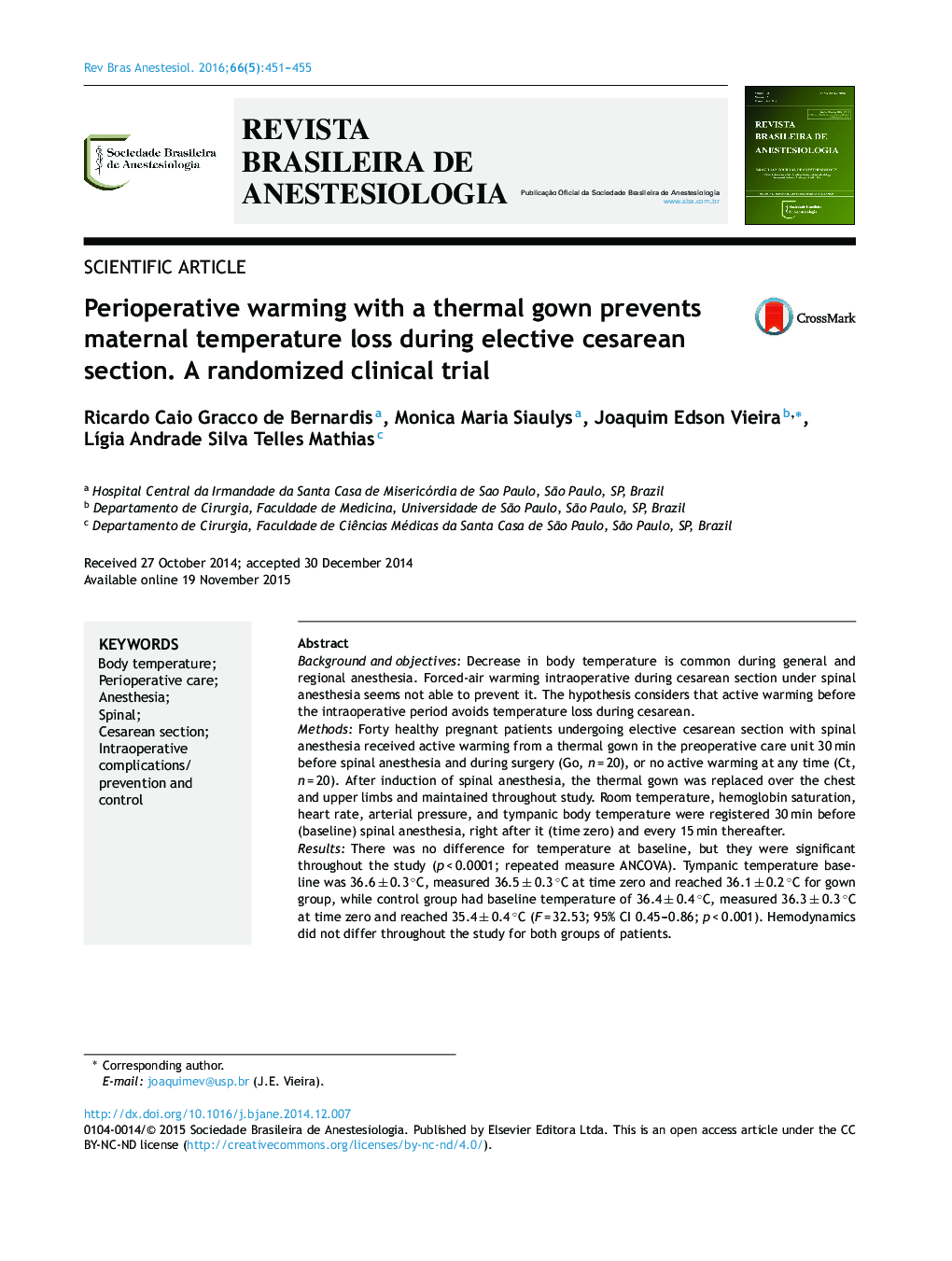| کد مقاله | کد نشریه | سال انتشار | مقاله انگلیسی | نسخه تمام متن |
|---|---|---|---|---|
| 2750057 | 1567296 | 2016 | 5 صفحه PDF | دانلود رایگان |
Background and objectivesDecrease in body temperature is common during general and regional anesthesia. Forced-air warming intraoperative during cesarean section under spinal anesthesia seems not able to prevent it. The hypothesis considers that active warming before the intraoperative period avoids temperature loss during cesarean.MethodsForty healthy pregnant patients undergoing elective cesarean section with spinal anesthesia received active warming from a thermal gown in the preoperative care unit 30 min before spinal anesthesia and during surgery (Go, n = 20), or no active warming at any time (Ct, n = 20). After induction of spinal anesthesia, the thermal gown was replaced over the chest and upper limbs and maintained throughout study. Room temperature, hemoglobin saturation, heart rate, arterial pressure, and tympanic body temperature were registered 30 min before (baseline) spinal anesthesia, right after it (time zero) and every 15 min thereafter.ResultsThere was no difference for temperature at baseline, but they were significant throughout the study (p < 0.0001; repeated measure ANCOVA). Tympanic temperature baseline was 36.6 ± 0.3 °C, measured 36.5 ± 0.3 °C at time zero and reached 36.1 ± 0.2 °C for gown group, while control group had baseline temperature of 36.4 ± 0.4 °C, measured 36.3 ± 0.3 °C at time zero and reached 35.4 ± 0.4 °C (F = 32.53; 95% CI 0.45–0.86; p < 0.001). Hemodynamics did not differ throughout the study for both groups of patients.ConclusionActive warming 30 min before spinal anesthesia and during surgery prevented a fall in body temperature in full-term pregnant women during elective cesarean delivery.
ResumoJustificativa e objetivosA redução da temperatura corporal é comum durante a anestesia tanto geral quanto regional. O sistema de ar forçado aquecido no intraoperatório durante a cesariana sob anestesia peridural não parece conseguir impedi-la. A hipótese considera que o aquecimento ativo antes do período intraoperatório evita a perda de temperatura durante a cesariana.MétodosQuarenta pacientes grávidas, saudáveis, submetidas à cesariana eletiva com anestesia espinal receberam aquecimento ativo de um avental térmico na unidade de cuidados pré-operatórios 30 minutos antes da anestesia e durante a cirurgia (Go, n = 20) ou nenhum aquecimento ativo a qualquer momento (Ct, n = 20). Após a indução da anestesia espinhal, o avental térmico foi colocado sobre o tórax e membros superiores e mantido durante o estudo. Temperatura ambiente, saturação de hemoglobina, frequência cardíaca, pressão arterial e temperatura corporal timpânica foram registradas 30 minutos antes (fase basal) da anestesia espinhal, logo após a anestesia (tempo zero) e a cada 15 minutos subsequentemente.ResultadosNão houve diferença de temperatura na fase basal, mas as diferenças foram significativas ao longo do estudo (p < 0,0001; ANCOVA de medida repetida). A temperatura timpânica na fase basal foi de 36,6 ± 0,3 °C, mediu 36,5 ± 0,3 °C no tempo zero e atingiu 36,1 ± 0,2 °C no grupo avental, enquanto a temperatura basal do grupo controle foi de 36,4 ± 0,4 °C, mediu 36,3 ± 0,3 °C no tempo zero e atingiu 35,4 ± 0,4 °C (F = 32,53; IC de 95% 0,45-0,86, p < 0,001). A hemodinâmica não diferiu ao longo do estudo em ambos os grupos de pacientes.ConclusãoO aquecimento ativo 30 minutos antes da anestesia espinhal e durante a cirurgia evitou a queda da temperatura corporal em mulheres grávidas a termo durante a cesariana eletiva.
Journal: Brazilian Journal of Anesthesiology (English Edition) - Volume 66, Issue 5, September–October 2016, Pages 451–455
